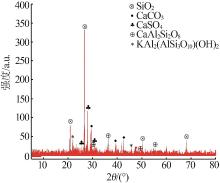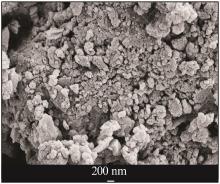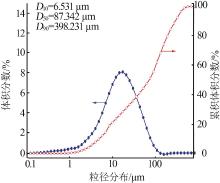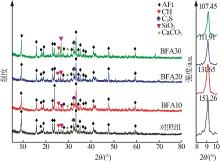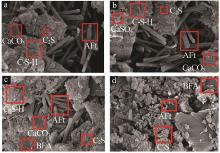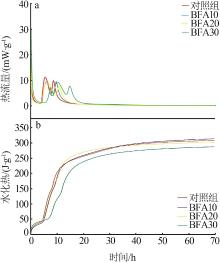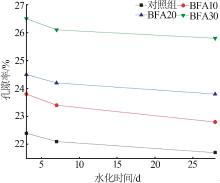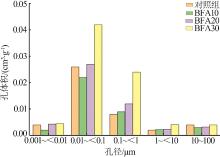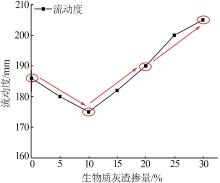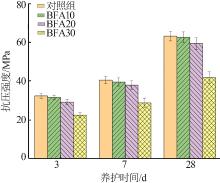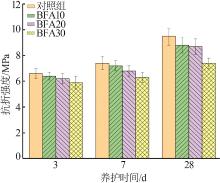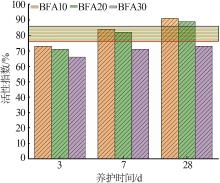Inorganic Chemicals Industry ›› 2023, Vol. 55 ›› Issue (10): 128-135.doi: 10.19964/j.issn.1006-4990.2023-0008
• Environment·Health·Safety • Previous Articles Next Articles
Study on performance of biomass power plant ash as alternative to cement clinker in blended cements
ZHANG Yanru1( ), REN Changzai2(
), REN Changzai2( ), SONG Zhanlong3, ZHU Jianjun1, ZHAO Baofeng2, XIE Hongzhang2, WANG Zhenjiang1, QI Xiaole1
), SONG Zhanlong3, ZHU Jianjun1, ZHAO Baofeng2, XIE Hongzhang2, WANG Zhenjiang1, QI Xiaole1
- 1.National Energy Bio-Power Group Co. ,Ltd. ,Beijing 100052,China
2.School of Energy and Power Engineering,Qilu University of Technology(Shandong Academy of Sciences),Jinan 250353,China
3.National Engineering Laboratory for Coal-fired Pollutants Emission Reduction,Shandong University,Jinan 250061,China
-
Received:2023-01-04Online:2023-10-10Published:2023-10-16 -
Contact:REN Changzai E-mail:zhangyr369@163.com;rcz@qlu.edu.cn
CLC Number:
Cite this article
ZHANG Yanru, REN Changzai, SONG Zhanlong, ZHU Jianjun, ZHAO Baofeng, XIE Hongzhang, WANG Zhenjiang, QI Xiaole. Study on performance of biomass power plant ash as alternative to cement clinker in blended cements[J]. Inorganic Chemicals Industry, 2023, 55(10): 128-135.
share this article
| 1 | 李鹏鹏,任强强,吕清刚,等.面向双碳的低碳水泥原料/燃料替代技术综述[J].洁净煤技术,2022,28(8):35-42. |
| LI Pengpeng, REN Qiangqiang, Qinggang LÜ,et al.Review on raw meal and fuel substitution technology for low carbon cement under carbon neutrality[J].Clean Coal Technology,2022,28(8):35-42. | |
| 2 | 王元战,许元晨,赵宇鹏,等.矿物掺合料混凝土的性能与环境效益综合评价方法[J].环境工程,2022,40(8):197-205,101. |
| WANG Yuanzhan, XU Yuanchen, ZHAO Yupeng,et al.Comprehensive evaluation method for performance and environmental benefits of mineral admixture concrete[J].Environmental Engineering,2022,40(8):197-205,101. | |
| 3 | ABDULKAREEM O A, RAMLI M, MATTHEWS J C.Production of geopolymer mortar system containing high calcium biomass wood ash as a partial substitution to fly ash:An early age evaluation[J].Composites Part B:Engineering,2019,174:106941. |
| 4 | FRÍAS M, MARTÍNEZ-RAMÍREZ S, DE LA VILLA R V,et al.Reactivity in cement pastes bearing fine fraction concrete and glass from construction and demolition waste:Microstructural analysis of viability[J].Cement and Concrete Research,2021,148:106531. |
| 5 | GAO Yifan, LI Zhaofeng, ZHANG Jian,et al.Synergistic use of industrial solid wastes to prepare belite-rich sulphoaluminate cement and its feasibility use in repairing materials[J].Construction and Building Materials,2020,264:120201. |
| 6 | GAN Min, FAN Xiaohui, CHEN Xuling,et al.Reaction mechanisms of low-grade molybdenum concentrate during calcification roasting process[J].Transactions of Nonferrous Metals Society of China,2016,26(11):3015-3023. |
| 7 | GAUR A, GURJAR S K, CHAUDHARY S.Circular system of resource recovery and reverse logistics approach:Key to zero waste and zero landfill[M]// Advanced Organic Waste Management:Sustainable Practices and Approaches. Amsterdam:Elsevier,2022:365-381. |
| 8 | CHEAH C B, RAMLI M.The implementation of wood waste ash as a partial cement replacement material in the production of structural grade concrete and mortar:An overview[J].Resources,Conservation and Recycling,2011,55(7):669-685. |
| 9 | CAREVIĆ I, SERDAR M, ŠTIRMER N,et al.Preliminary screening of wood biomass ashes for partial resources replacements in cementitious materials[J].Journal of Cleaner Production,2019,229:1045-1064. |
| 10 | CAREVIĆ I, BARIČEVIĆ A, ŠTIRMER N,et al.Correlation between physical and chemical properties of wood biomass ash and cement composites performances[J].Construction and Building Materials,2020,256:119450. |
| 11 | CASTELLANI V, BENINI L, SALA S,et al.A distance-to-target weighting method for Europe 2020[J].The International Journal of Life Cycle Assessment,2016,21(8):1159-1169. |
| 12 | CASTILLO CASTILLO A, ANGELIS-DIMAKIS A.Analysis and recommendations for European carbon dioxide utilization policies[J].Journal of Environmental Management,2019,247:439- 448. |
| 13 | DINGA C D, WEN Zongguo.China’s green deal:Can China′s cement industry achieve carbon neutral emissions by 2060?[J].Renewable and Sustainable Energy Reviews,2022,155:111931. |
| 14 | CHEN S C, LIN H C, CHEN Weiyu.Risks of consuming cadmi-um-contaminated shellfish under seawater acidification scenario:Estimates of PBPK and benchmark dose[J].Ecotoxicology and Environmental Safety,2020,201:110763. |
| 15 | AL-AYISH N, DURING O, MALAGA K,et al.The influence of supplementary cementitious materials on climate impact of concrete bridges exposed to chlorides[J].Construction and Building Materials,2018,188:391-398. |
| 16 | CORDEIRO G C, FILHO R D T,DE MORAES REGO FAIRBAIRNE. Use of ultrafine rice husk ash with high-carbon content as pozzolan in high performance concrete[J].Materials and Structures,2009,42(7):983-992. |
| 17 | CORDEIRO G C, TOLEDO FILHO R D, TAVARES L M,et al.Pozzolanic activity and filler effect of sugar cane bagasse ash in Portland cement and lime mortars[J].Cement and Concrete Composites,2008,30(5):410-418. |
| 18 | CORONA B, SHEN Li, SOMMERSACHER P,et al.Consequential life cycle assessment of energy generation from waste wood and forest residues:The effect of resource-efficient additives[J].Journal of Cleaner Production,2020,259:120948. |
| 19 | 宋强,张琼琼,徐德龙.熟料氧化镁含量对水泥浆水化与收缩的影响[J].硅酸盐学报,2017,45(5):644-650. |
| SONG Qiang, ZHANG Qiongqiong, XU Delong.Effect of magnesia in clinker on shrinkage and hydration of cement paste[J].Journal of the Chinese Ceramic Society,2017,45(5):644-650. | |
| 20 | SÁEZ DEL BOSQUE I F, MEDINA J M, FRÍAS M,et al.Use of biomass-fired power plant bottom ash as an addition in new blended cements:Effect on the structure of the C-S-H gel formed during hydration[J].Construction and Building Materials,2019,228:117081. |
| 21 | DEMIS S, TAPALI J G, PAPADAKIS V G.An investigation of the effectiveness of the utilization of biomass ashes as pozzolanic materials[J].Construction and Building Materials,2014,68:291-300. |
| 22 | BRAZÃO FARINHA C, DE BRITO J, VEIGA R.Influence of forest biomass bottom ashes on the fresh,water and mechanical behaviour of cement-based mortars[J].Resources,Conservation and Recycling,2019,149:750-759. |
| 23 | DEBOUCHA W, LEKLOU N, KHELIDJ A,et al.Hydration development of mineral additives blended cement using thermogravimetric analysis(TGA):Methodology of calculating the degree of hydration[J].Construction and Building Materials,2017,146:687-701. |
| 24 | REN Changzai, WANG Wenlong, HUA Dongliang,et al.Preparation and properties of a sulphoaluminate magnesium-potassium phosphate green cementitious composite material from industrial solid wastes[J].Materials,2021,14(23):7340. |
| 25 | TEIXEIRA E R, CAMÕES A, BRANCO F G,et al.Recycling of biomass and coal fly ash as cement replacement material and its effect on hydration and carbonation of concrete[J].Waste Management,2019,94:39-48. |
| 26 | 何青峰,曾利群,何朝晖,等.除氯处理的PAC废渣的细度和掺量对水泥性能影响的研究[J].无机盐工业,2020,52(4):84-87. |
| HE Qingfeng, ZENG Liqun, HE Zhaohui,et al.Study on effect of fineness and dosage of PAC waste residue on cement performance[J].Inorganic Chemicals Industry,2020,52(4):84-87. | |
| 27 | 桂彬,陈鸿,杨林,等.石灰-水泥-粉煤灰改性磷石膏对水泥物理性能的影响研究[J].无机盐工业,2022,54(12):92-98. |
| GUI Bin, CHEN Hong, YANG Lin,et al.Effect of phosphogypsum modified by lime-cement-fly ash on physical properties of cement[J].Inorganic Chemicals Industry,2022,54(12):92-98. |
| [1] | LI Keke, XUE Jiangwei, WANG Luwei, GUAN Xuemao. Effect of MgAl-layered double hydroxides on properties of high-iron low-calcium portland cement [J]. Inorganic Chemicals Industry, 2024, 56(4): 57-63. |
| [2] | YU Zhou, HE Zhaoyi, TANG Liang, HE Sheng, XIAO Haixin, XIAO Yixun. Study on preparation and microscopic properties of typical sulfate solid waste composite cementitious materials [J]. Inorganic Chemicals Industry, 2024, 56(4): 90-97. |
| [3] | CUI Gengyin, XIE Lang, LU Yuexian, KONG Dewen, WANG Lingling. Optimization of mechanical properties of basalt fiber reinforced phosphogypsum-based composites based on RSM [J]. Inorganic Chemicals Industry, 2023, 55(8): 116-123. |
| [4] | WANG Yue, FANG Guoxiang, ZHANG Daoming, WANG Weicheng. Effect of nanosilica on gelling properties of hydraulic lime [J]. Inorganic Chemicals Industry, 2023, 55(7): 75-80. |
| [5] | XU Li, FANG Keneng, BI Yongxiang, YANG Min, CHEN Qianlin. Preparation of modified granular-like CaSO4 and its application in polyvinyl chloride [J]. Inorganic Chemicals Industry, 2023, 55(3): 104-112. |
| [6] | CHEN Mingsheng,LIU Peng,KONG Dewen,LI Yuan,YU Ke,HUANG Yansen,WU Ningbo,CHANG Juanjuan. Effect of external admixtures on mechanical and thermal conductivity of phosphogypsum composite cementitious materials [J]. Inorganic Chemicals Industry, 2022, 54(9): 113-118. |
| [7] | XU Lihua,HUANG Zheng,ZHANG Xing,DU Huaiming,CHEN Xiaochao,HUANG Bin. Preparation and properties of composite materials from natural gas?based acetylene process produced carbon black and silica [J]. Inorganic Chemicals Industry, 2022, 54(5): 121-125. |
| [8] | WANG Yuan,WANG Zhi,QIN Hongyi. Study on properties of wet detoxification Fe-Cr slag as concrete admixture [J]. Inorganic Chemicals Industry, 2022, 54(3): 87-90. |
| [9] | LÜ Fangtao,ZHOU Yinsheng,KONG Dewen,CHEN Sihan,AN Hongfang,WANG Lingling. Effect of hybrid fiber on properties of desulfurized gypsum based composite cementitious material [J]. Inorganic Chemicals Industry, 2022, 54(10): 127-132. |
| [10] | Liu Yuhong,Yin Chunlin,Ma Shunyou,Yan Xin,Yuan Xiaochao,Leng Jianjun,Zhang Jin. Preparation of colored zirconia ceramics by adding alumina-chrome slag from aluminothermic reduction [J]. Inorganic Chemicals Industry, 2021, 53(3): 78-83. |
| [11] | Wang Guosheng,Han Siyu,Tang Fengxiang,Xu Ronghui. Preparation and properties of modified basic magnesium chloride whisker/styrene butadiene rubber composites [J]. Inorganic Chemicals Industry, 2020, 52(3): 51-54. |
| [12] | Chen Peng,Zhang Chenhu,Wang Chengyong,Shi Kaiyi,Lei Yizhu. Research status of main properties of basalt fiber [J]. Inorganic Chemicals Industry, 2020, 52(10): 64-67. |
| [13] | WANG Na, ZHONG Jian-Chu, WANG Hong-Zhi. Preparation, characterization and application of calcium and aluminum layered double hydroxides intercalated by boric acid radical [J]. INORGANICCHEMICALSINDUSTRY, 2016, 48(1): 25-. |
| [14] | TANG Jian, LI Xiu-Ping. Thinking on survival and development of titanium dioxide industry under low carbon economy in China [J]. INORGANICCHEMICALSINDUSTRY, 2012, 44(7): 6-. |
| [15] | CAO Yin, YANG Hui. Application progress of microreactors in synthesis of inorganic materials [J]. INORGANICCHEMICALSINDUSTRY, 2011, 43(5): 7-. |
| Viewed | ||||||
|
Full text |
|
|||||
|
Abstract |
|
|||||
|
||
